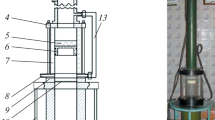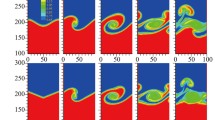Abstract
We present the results of a large number of 2D and 3D simulations of the Rayleigh–Taylor instability development. The simulations were made with the help of the EGAK code developed at RFNC–VNIIEF and performed using fine grids (for 2D, 1000 × 2000; for 3D, 10003) for two ideal fluids of different densities in the gravitational field with different initial perturbations at the interface. We present an analysis of the results of 2D and 3D simulations compared with the evolutionary model of a turbulent mixing layer. This theoretical approach is based on the idea of a “perturbation age” where the age of a perturbation is the product of its height and the wave number. The “critical age” represents the boundary between the linear and nonlinear stages of the instability development (a boundary that is different for 2D and 3D problems). Central in this model is information on the initial perturbation spectra and their role in the appearance of low wave-number modes at a later stage of the turbulent mixing layer evolution. The instability evolution model enables an adequate interpretation of various peculiarities in the development of a turbulent layer.
Similar content being viewed by others
References
S. Z. Belen’ki and E. S. Fradkin, Proceedings of the Lebedev Physical Institute, Nauka, Moscow (1965), Vol. 29, p. 207 [in Russian].
J. R. Ristorcelli and T. T. Clark, J. Fluid Mech., 507, 213 (2004).
N. A. Inogamov, Tech. Phys. Lett., 4, 743 (1978).
V. Rozanov, “Evolution Model of Turbulent Mixing,” Talk at the XII International Workshop on the Physics of Compressible Turbulent Mixing (Moscow, Russia, 12–17 July 2010).
V. E. Neuvazhaev, Numerical Simulation of Turbulent Mixing, The Russian Federal Nuclear Center – All-Russian Research Institute of Technical Physics, Snezhinsk, Russia (2007).
D. H. Olson and J. W. Jacobs, Phys. Fluids, 21, 034103 (2009).
J. Hetch, D. Ofer, U. Alon, et al., Laser Part. Beams, 13, 423 (1995).
N. V. Zmitrenko, N. G. Proncheva, and V. B. Rozanov, “The evolution model of a turbulent mixing layer,” Preprint No. 65, Lebedev Physical Institute, Moscow (1997).
V. Rozanov, R. Yakhin, N. Zmitrenko, et al., “RT instability development and mixing: The analysis of 3D simulations, in view of the evolution model,” Talk at the XIII International Workshop on the Physics of Compressible Turbulent Mixing (Woburn, UK, 2012).
P. Kuchugov, N. Zmitrenko, V. Rozanov, et al., “RT instability development and mixing: The analysis of 2D simulations and comparison with the 3D ones, in view of the evolution model,” Talk at the XIII International Workshop on the Physics of Compressible Turbulent Mixing (Woburn, UK, 2012).
G. Dimonte, D. L. Youngs, A. Dimits, et al., Phys. Fluids, 16, 1668 (2004).
V. B. Rozanov and N. V. Zmitrenko, “Growth rates of Kelvin–Helmholtz instabilities in the problem of laser fusion,” Preprint No. 16, Lebedev Phisical Institute, Moscow (1992) [in Russian].
Yu. V. Yanilkin, S. P. Belyaev, Yu. A. Bondarenko, et al., Proceedings of the Russian Federal Nuclear Center – All-Russian Research Institute of Experimental Physics, Sarov, Russia (2008), Vol. 12, p. 54 [in Russian].
E. Fermi and J. von Neumann, Taylor Instability of Incompressible Liquids, United States Atomic Energy Commission, Technical Information Service, Oak Ridge, Tennessee (1953), AECU-2979.
A. W. Cook, W. Cabot, and P. L. Miller, J. Fluid Mech., 511, 333 (2004).
N. N. Anuchina, V. I. Volkov, V. A. Gordeychuk, et al., J. Comput. Appl. Math., 168, 11 (2004).
Author information
Authors and Affiliations
Corresponding author
Rights and permissions
About this article
Cite this article
Rozanov, V.B., Kuchugov, P.A., Zmitrenko, N.V. et al. Effect of Initial Conditions on the Development of Rayleigh–Taylor Instability. J Russ Laser Res 36, 139–150 (2015). https://doi.org/10.1007/s10946-015-9487-y
Received:
Published:
Issue Date:
DOI: https://doi.org/10.1007/s10946-015-9487-y




